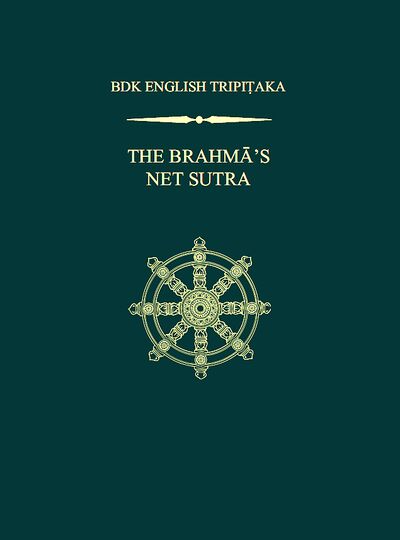The Brahmā's Net Sutra
< Books
| Line 28: | Line 28: | ||
***{{i|9. The Mental State of Joy|12}} | ***{{i|9. The Mental State of Joy|12}} | ||
***{{i|10. The Summit Mental State|12}} | ***{{i|10. The Summit Mental State|12}} | ||
| − | |||
**{{i|The Ten Nourishing Mental States|13}} | **{{i|The Ten Nourishing Mental States|13}} | ||
***{{i|1. The Mental State of Kindness|13}} | ***{{i|1. The Mental State of Kindness|13}} | ||
| Line 62: | Line 61: | ||
***{{i|9. The Ground of the Flower Ornamentation of the Essence|34}} | ***{{i|9. The Ground of the Flower Ornamentation of the Essence|34}} | ||
***{{i|10. The Ground of Entry into the Buddha Realm of the Essential Nature|35}} | ***{{i|10. The Ground of Entry into the Buddha Realm of the Essential Nature|35}} | ||
| + | |||
| + | *Fascicle 2. The Precepts | ||
| + | **{{i|Preface to the Bodhisattva Precepts of the ''Brahmā's Net Sutra''|37}} | ||
| + | **{{i|Invocation|38}} | ||
| + | **{{i|The Teaching Transmitted to the Transformation-body Buddhas|38}} | ||
| + | **{{i|Repayment of Kindness and a Separate Iteration of the Teaching|39}} | ||
| + | **{{i|The Exhortation|40}} | ||
| + | **{{i|The Bodhisattva Precepts|41}} | ||
| + | ***{{i|The Transmission and Remembrance of the Founding Teacher|41}} | ||
| + | **{{i|Preface to the Formation of the Precepts|42}} | ||
| + | ***{{i|Interlocutor’s Preface|42}} | ||
| + | ***{{i|The Preface of the World-honored One|42}} | ||
| + | ****{{i|The Preface of the Preceptor|42}} | ||
| + | ****{{i|The Dharma Preface|43}} | ||
| + | ****{{i|The Preface for the Disciples|43}} | ||
| + | **{{i|The Main Sermon|43}} | ||
| + | ***{{i|Introduction of the Exhortation to Uphold|43}} | ||
| + | **{{i|The Ten Grave Precepts|44}} | ||
| + | ***{{i|1. Prohibition of Killing for Pleasure|44}} | ||
| + | ***{{i|2. Prohibition of Stealing Others’ Property|44}} | ||
| + | ***{{i|3. Prohibition of the Heartless Pursuit of Lust|44}} | ||
| + | ***{{i|4. Prohibition of Intentional Lying|45}} | ||
| + | ***{{i|5. Prohibition of the Sale of Alcohol|45}} | ||
| + | ***{{i|6. Prohibition of Speaking of the Faults of Others|45}} | ||
| + | ***{{i|7. Prohibition of Praising Oneself and Disparaging Others|46}} | ||
| + | ***{{i|8. Prohibition of Parsimony and Abuse of Others|46}} | ||
| + | ***{{i|9. Prohibition of Holding Resentments and Not Accepting Apologies|46}} | ||
| + | ***{{i|10. Prohibition of Denigration of the Three Treasures|47}} | ||
| + | **{{i|Conclusion|47}} | ||
| + | **{{i|The Minor Precepts|48}} | ||
| + | ***{{i|Division of Ten Precepts|48}} | ||
| + | ****Precepts Concerning the Guarding of One's Own Thoughts | ||
| + | *****{{i|1. Do Not Show Disrespect to Senior Teachers|48}} | ||
| + | *****{{i|2. Do Not Drink Alcohol|48}} | ||
|StopPersonRedirects=No | |StopPersonRedirects=No | ||
}} | }} | ||
Revision as of 14:44, 27 July 2021
The Brahmā’s Net Sutra is the primary extant vinaya text that articulates a set of precepts from a Mahayana perspective, mainly intended for "bodhisattva practitioners" primarily householders, rather than renunciant monks or nuns. Before the appearance of this text the monastic rules and regulations in East Asian Buddhism were defined fully by the "Hinayana" vinaya, most importantly the Four-part Vinaya associated with the Dharmaguptaka school in India. With the appearance of the Brahmā’s Net Sutra many East Asian schools diversified their precept practices, with some groups of practitioners taking up either set of precepts, often utilizing both.
Composed in China around 420, the Brahmā’s Net Sutra is based on various contemporary Mahayana and Hinayana vinaya writings and includes extensive discussion of indigenous Chinese moral concepts such as filial piety, etc. The text is based in the same mainstream Mahayana thought of the Flower Ornament Sutra (Huayan jing), the Nirvana Sutra (Niepan jing), and the Sutra for Humane Kings (Renwang jing). In fact, the extent of the Brahmā's Net Sutra's agreement with the Flower Ornament Sutra is so pronounced that it is regarded as the "concluding sutra" of the latter.
Long thought to be the Skt. Brahmajāla-sūtra translated by Kumārajīva into the Chinese as Fanwang jing (梵網經), the work is now seen within modern scholarship as composed in China around 420, based on various Mahayana and Hinayana vinaya writings available at that time. 2 fascicles. (Source: BDK America)
| Citation | Muller, A. Charles, and Kenneth K. Tanaka, trans. The Brahmā's Net Sutra: (Taishō Volume 24, Number 1484). Moraga, CA: BDK America, 2017. |
|---|---|

